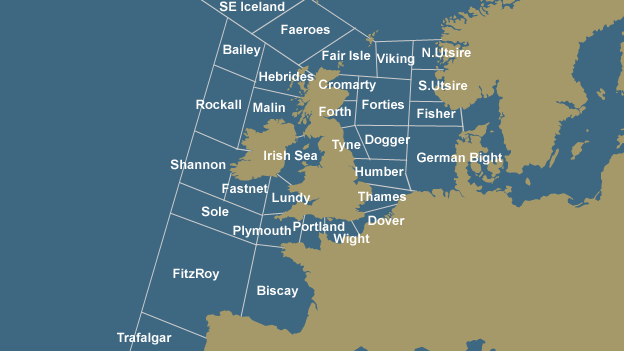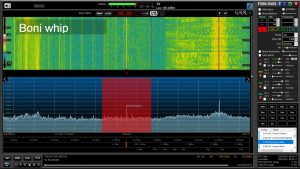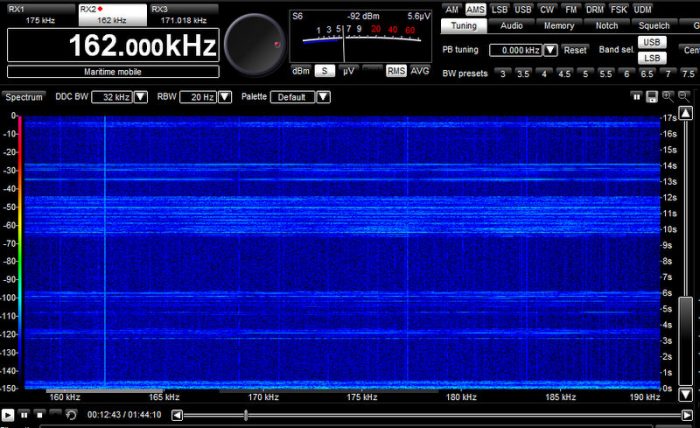 Many thanks to SWLing Post reader, George, who writes:
Many thanks to SWLing Post reader, George, who writes:
With all of the recent postings about the Shipping Forecast, I thought I’d share this excellent little video produced by the Met Office:
Click here to view on YouTube.
Thank you, George!

 Many thanks to SWLing Post reader, George, who writes:
Many thanks to SWLing Post reader, George, who writes:
With all of the recent postings about the Shipping Forecast, I thought I’d share this excellent little video produced by the Met Office:
Click here to view on YouTube.
Thank you, George!
Hi there, if like me, you live in an urban environment, chances are QRM is having a negative impact on the quality of the signals you’re receiving at home. The presence of electrical noise makes antenna choice very important, particuarly if you’re planning to spend more than a few £££s on something more sophisticated than a length of wire. Recently I was considering the the purchase of a secon d compact antenna, for use at home in my shack and out and about on DXpeditions. I already had the excellent Wellbrook ALA1530 H field antenna, but at more than £250, it’s very costly and thus it seemed rather extravagent to buy a second one, if I could find something with similar performance for less expense. Space is at a premium at home and of course I take much of my equipment out on DXpeditions, so the Bonito Boni whip active antenna appeared to be an ideal choice. A wideband active antenna (from 20 kHz to 300 MHz) operating from 12 to 15V DC, with a very compact form-factor definitely ticked all the boxes. Furthermore, with reasonable second and third order intercept points of +55 and +32.5 dBm respectively, the Boni whip, on paper at least, looked like a pretty good buy at around £100.
d compact antenna, for use at home in my shack and out and about on DXpeditions. I already had the excellent Wellbrook ALA1530 H field antenna, but at more than £250, it’s very costly and thus it seemed rather extravagent to buy a second one, if I could find something with similar performance for less expense. Space is at a premium at home and of course I take much of my equipment out on DXpeditions, so the Bonito Boni whip active antenna appeared to be an ideal choice. A wideband active antenna (from 20 kHz to 300 MHz) operating from 12 to 15V DC, with a very compact form-factor definitely ticked all the boxes. Furthermore, with reasonable second and third order intercept points of +55 and +32.5 dBm respectively, the Boni whip, on paper at least, looked like a pretty good buy at around £100.
Now, clearly, an E field antenna such as the Boni whip is not going to match the SNR provided by the H field Wellbrook ALA1530 in a noisy, urban environment. I have uploaded a few reception videos to my YouTube channel to demonstrate this, making a direct comparison of the two. However, what about the performance of the whip versus a simple longwire in an urban environment? Is there a delta in performance? The value proposition of the whip is primarliy in it’s performance, coupled with portability I suppose, but that must be considered a secondary requirement. The whip might be 10 or 15 times more expensive than a reel of cheap equipment wire, but will the reception justify the cost delta?!
Text links follow directly below, with embedded videos thereafter; you will find 3 reception videos comparing the whip and a 30 metre longwire, on shortwave and one each for LW and MW. At the end of each video there’s a section with the Wellbrook loop, just to calibrate where the longwire and whip are in terms of a much more effective H field antenna. The result? Well, there’s not much to separate the longwire and Boni whip, except on LW, where the whip prevails. A friend told me recently, if reception is rubbish at home under a blanket of QRM, don’t blame the antenna, the noise is the real problem. He was right. So, the next tests are to be undertaken out in the field, where the whip has a real chance to shine. I’m rooting for it because to have an antenna that performs as well as, or close to my loop out in the woods, yet can be packed away into a small case would be brilliant. Thanks for reading/watching/listening.
Clint Gouveia is the author of this post and a regular contributor to the SWLing Post. Clint actively publishes videos of his shortwave radio excursions on his YouTube channel: Oxford Shortwave Log. Clint is based in Oxfordshire, England.
Now an annual Christmas tradition, Brian Justin (WA1ZMS) will put his longwave experimental station WI2XLQ on the air to commemorate the 110th anniversary of Reginald Fessenden’s first audio transmission.
WI2XLQ will broadcast under its new callsign (formerly WG2XFQ) on 486 kHz from Forest, Virginia, beginning on December 24 at 0001 UTC. WI2XLQ will remain on the air for 48 hours.
Listener reports may be sent to Brian Justin, WA1ZMS, at his QRZ.com address.
If you would like more information about Brian Justin and WI2XLQ, check out our interview with him in 2013. Indeed, I successfully heard the 2013 WG2XFG broadcast and posted this audio clip on the Shortwave Radio Audio Archive.
Additionally, SWLing Post reader, George Stein has a very personal connection with radio pioneer, Reginald Fessenden: click here to read his story.
 (Source: Southgate ARC via Mike Barraclough)
(Source: Southgate ARC via Mike Barraclough)
French 162 kHz Broadcast Licence
The French Superior Council of Audiovisual (Content), CSA, is calling for expressions of interest in broadcasting on 162 kHz
They say: In accordance with the provisions of Article 26 of the amended Freedom of Communication Act of September 30, 1986 and at the request of the Government, the CSA decided to withdraw from Radio France the use of the 162 kHz frequency for broadcasting of France Inter.
In order to determine whether the Commission should initiate the procedures necessary to appeal the 162 kHz frequency, it decided to issue a call for expressions of interest for the broadcast of a radio service on the 162 kHz frequency.
Responses are expected no later than January 16, 2017.
Announcement in French
http://www.csa.fr/Espace-juridique/Decisions-du-CSA/Frequence-radio-162-kHz-appel-a-manifestation-d-interet
If you’ve been wanting to log France Inter as longwave DX, you’re running out of time. France Inter is shutting down their 162 kHz longwave service on December 31, 2016.
I’m grateful to SWLing Post contributor, Ron, who has persistently reminded me that these are some of the last days to catch France Inter as LW DX here in North America. Indeed, he shared a bit of interesting and encouraging news a couple weeks ago:
On the Radiodiscussions DX forum, Jim Farmer over in San Antonio got and recorded France Inter on 162 khz using a PK loop and Sony 7600GR.
The PK Loop he’s referring to is this one and, of course, the Sony ICF-SW7600GR is one of my staple portables.
While I’d love to try to grab France Inter with my Sony, my schedule makes it very difficult to arrange. Fortunately, I have SDRs which allow me to record spectrum throughout the night, then review the recordings in the morning.
Throughout the month of December, I’ve been recording a small chunk of longwave spectrum–with my WinRadio Excalibur–during the night and reviewing it in the morning in hopes that I could grab an opening from France Inter.
I was rewarded on December 19, 2016 around 0300 UTC. Though there was atmospheric noise that night in the form of static crashes, I snagged France Inter on 162 kHz.
The 162 kHz carrier was barely above the noise floor (see above), so it was certainly weak signal DX. Here’s an audio sample:
Click here to download the mp3 file.
When that short LW opening happened, I was also able to snag Medi 1 from Morocco on 171 kHz. Again, not fantastic copy, but I’m happy:
Click here to download the mp3.
Mind you, both France Inter and Medi 1 only transmit at 2,000 watts–that’s flea power compared to our shortwave broadcasters. It’s amazing those signals can even hop the Atlantic.
Correction…an SWLing Post reader, qwerty.am, comments:
Actually, the power of France Inter and Medi1 is 2000 kW and 1600 kW respectively. So the power of most SW broadcasters should be called a “flea power” in comparison to what is used on longwave. The smallest output on LW band in Europe is 50 kW, it’s used by Denmark and Czech Rep. The 162 kHz transmitter is closing on Dec 26th, according to the latest news.
Wow!
Again, if you’d like to grab longwave stations before they disappear, now is the time! Our LW broadcasters are disappearing rapidly. Fortunately, winter (here in the northern hemisphere) is the best time to chase LW DX.
Thanks, again, Ron for your encouragement! I’ll keep listening and recording!
Contrary to a news item we recently shared from The Independent, SWLing Post contributor, Mike Barraclough, notes the following news from the Irish Post:
RTÉ RADIO will proceed with plans to axe its longwave 252 service next year, it has been confirmed.
[…]RTÉ has consistently argued that better use could be made of the money and that listeners should consider other options, such as internet and satellite receivers, to tune in to their favourite shows.
Despite undertaking a survey of almost 3,000 longwave 252 listeners in Britain last year, in conjunction with Middlesex University London and the Irish in Britain charity, the broadcaster will now go ahead with the move.
The survey had revealed that the service was a vital “lifeline” for many elderly listeners, and an important link to their homeland.
[…]The Irish in Britain organisation, which helped facilitate the RTÉ survey, today said that they would be meeting with the consultative steering group in the next few weeks to discuss the next steps for the campaign to save longwave.
Chief Executive Peter McNulty told The Irish Post: “We will be sitting down with the consultative group to review the situation and discuss the research to see how we can move forward.
“The research is very clear that there is a demand for this type of service from the Irish community here in Britain. That link with home is very important.”
RTÉ would not reveal when in 2017 they plan to close the longwave service.
(Source: Independent.ie via London Shortwave)
RTE is set to scrap controversial plans to axe its longwave radio service, aimed at saving the cash-strapped broadcaster €250,000 a year, the Sunday Independent has learned.
As the station grapples with an unprecedented financial crisis, it was announced two years ago that it planned to wind down longwave 252 broadcasts before full shutdown in May 2017.
But the plan caused widespread anger, particularly among the Irish community in Britain, where the service is seen as a crucial lifeline for thousands of older emigrants who cannot access digital broadcasts.
RTE sources say the service was targeted for shutdown because it is considered outdated, and is an ongoing and unnecessary cost, during a time of increasing financial pressures.
However, as a result of a public backlash, the broadcaster was forced to temporarily postpone the closure until 2017, giving listeners more time to move over to digital platforms.But the station has confirmed it is now carrying out a “review” of its previous announcement.
A spokesperson added that there is now no specific date for the termination of the service. However, it is understood there remains an ongoing risk as regards its long-term viability.[…]Many of the older emigrants left Ireland in the 1950s – with only basic education – as Ireland grappled with widespread unemployment.
They are now elderly and a significant number are in difficult financial circumstances, according to social services.
This radio service is still a crucial ‘link with home’ for many thousands of older Irish in Britain, according to various immigrant groups working with social services.